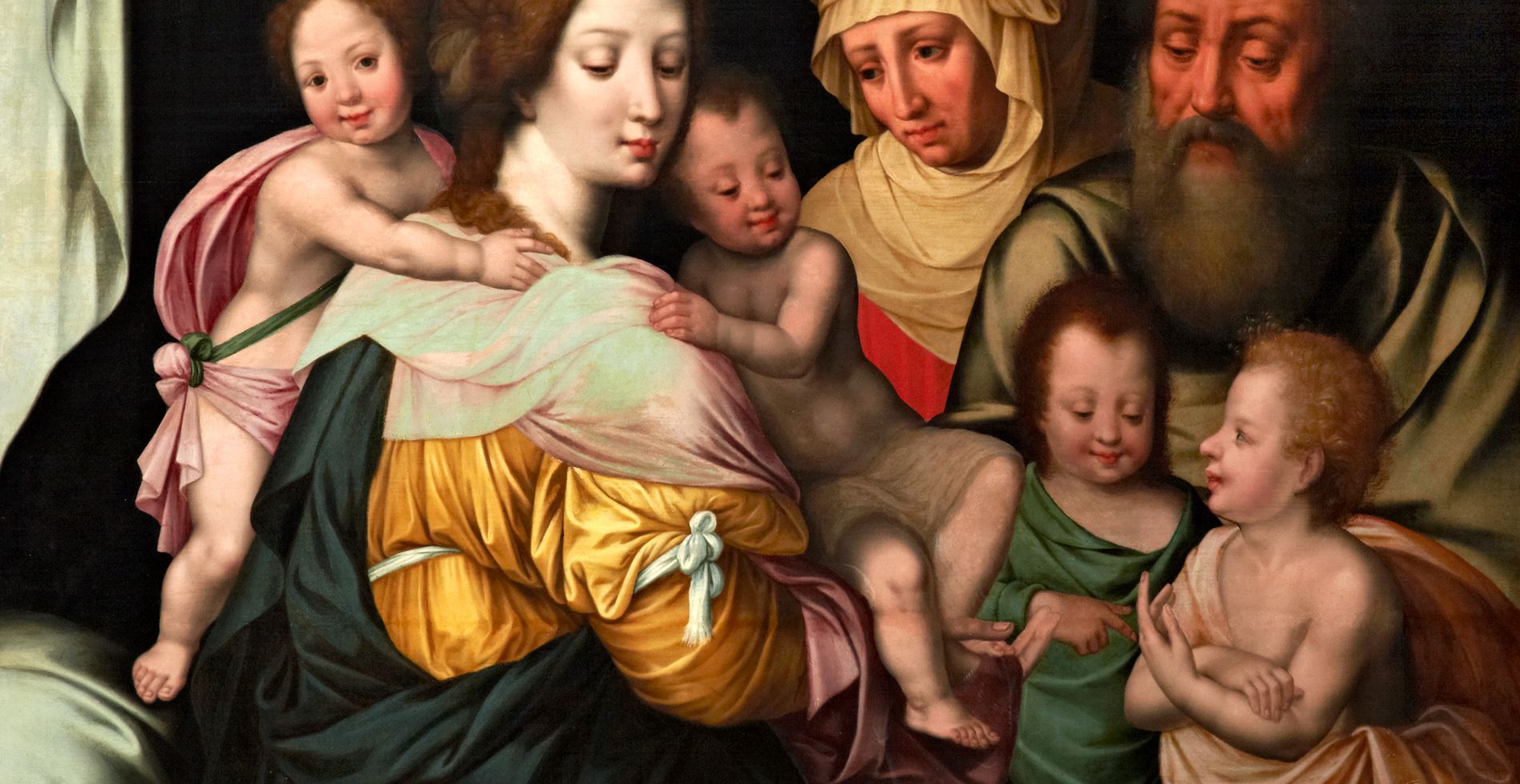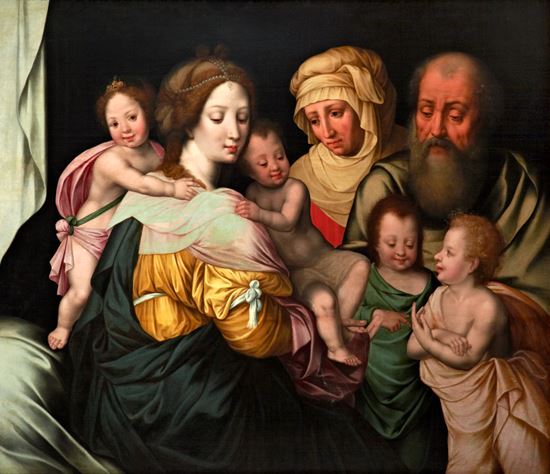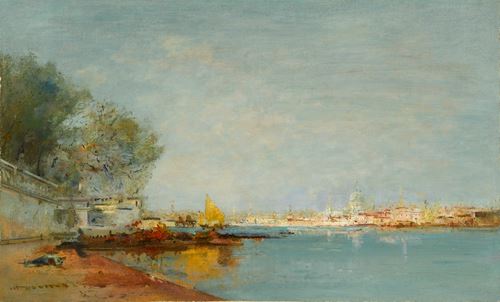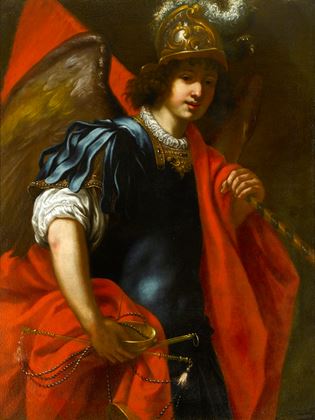incent Sellaer
(active in Malines before 1538 - after 1544)
The Holy Kinship
oil on panel
94.6 x 108.6 cm (37 1/4 x 42 3/4 in)
This subtly animated and beautifully rendered scene of The Holy Kinship, demonstrates many of the stylistic traits and the originality for which Vincent Sellaer is held in such regard. The Virgin sits with her back to the viewer but leans around in order to display the Christ child. Watching over the mother and child are the figures of St. Joseph and St. Elizabeth. The presence of St. Elizabeth suggests that one of the three other infants may be her son St. John the Baptist, most likely the boy dressed in green standing closest to Christ. The other two infants are likely to be cousins of Christ, although their exact identities cannot be identified due to the lack of attributes. The three adult saints all bear sober and pensive expressions; St. Margaret in particular bears a sombre expression as she stares at the Christ child, contemplating his future sacrifice. In comparison the infants are much more playful; three of them cheerfully play amongst themselves whilst a fourth climbs onto the Virgin’s back and this figure is the only one who directly meets the viewer’s eye, thus engaging us with the scene.
‘The Holy Kinship’ was a theme that flourished in Northern European Art throughout the fifteenth and sixteenth centuries, which derived from the genealogy of Christ’s maternal grandmother, St. Anne, as laid out in the Jacobus de Voragine’s (c.1230-1298) Golden Legend. In the Gospels the evangelists provide conflicting records of Christ’s extended family and to account for this a late medieval legend developed which stated that St. Anne was married three times, and her children and grandchildren from these three separate marriages formed Christ’s extended familly. As Jacobus writes:
‘Anna is usually said to have conceived three Marys,
Whom her husbands Joachim, Cleophas, and Salome begot.
These [Marys] the men Joseph, Alpheus, and Zebedee took in marriage.
The first bore Christ; the second bore James the Less,
Joseph the Just, with Simon [and] Jude;
The third, James the Greater and the winged John.’¹
By this account five of the twelve apostles were cousins of Christ, in addition to John the Baptist. This version of Christ’s family tree reconciled a problem which theologians from St. Jerome onwards had grappled with. When the subject was depicted in art, those members of Christ’s generation were traditionally depicted as infants, as seen in Sellaer’s treatment of the subject.
The theme of ‘The Holy Kinship’ was one of Sellaer’s favoured subjects, and one which he depicted on several occasions. Some depictions have almost identical compositions to the present work, an example of which hangs in the basilica of Our Lady of the Assumption in Zwolle, in the Netherlands.² The differences between this work and the present painting are minimal; the Virgin’s costume differs in colour and in the Zwolle painting the figures feel more crowded in the pictorial space because the composition has been slightly cropped on all sides. However, despite the slightly more cramped composition the Zwolle painting maintains the same emphasis on the individualisation and psychological insight of the figures which is such a feature of the present work.
As already mentioned, the identification of the infants in The Holy Kinship is problematic due to the lack of attributes. The problem of attribution for the figures is further complicated when comparing the present work to another of Sellaer’s works, The Holy Family with the Infant St. John, St. Elizabeth and St. Anne, which hangs in Copenhagen.The figure on the right-hand side would seem to be St. Elizabeth, due to the traditional depiction of her as a veiled old lady, and she is clearly comparable to the corresponding figure in The Holy Kinship. However, the depiction is contradictory because she holds an open book, one of St. Anne’s traditional attributes, and her son, St. John the Baptist, has been placed away from her. Despite this it seems that St. Anne must be the left-hand female; the combination of red and green costume is traditional, as is the positioning of the Virgin, so that it appears as if she is almost sitting in her mother’s lap. Both The Holy Kinship and the Copenhagen work highlight the problems of attributing figures in some of Sellaer’s work. Furthermore, when discussing a version of The Holy Kinship, which hangs in Scheffler Palace in Stockholm, Richard Litell identifies the male figure as Zechariah.³ These problems of attribution in Sellear’s work, reflects the fact that narrative clarity was not always a priority for the artist.
The inclusion of infants in The Holy Kinship is characteristic of Sellaer’s work in general. In the majority if his work these children ‘become protagonists of mythological and devotional compositions alike’, animating both religious and secular scenes with their movement and round smiling faces.⁴ Another of Sellaer’s favoured subjects was depictions of Charity, and the standard depiction of this virtue in the sixteenth century was of a woman surrounded by infants. Similarly his Leda and the Swan, with Children (Private Collection) contains the same type of child, with their tight auburn curls, round noses and cheerful expressions. As can be seen in both of these works, and in The Holy Kinship, the motif of a child climbing onto the back of the central female figure was one of Sellaer’s favoured devices. One can therefore consider the inclusion of the infants in The Holy Kinship, whilst bearing in mind the lack of attributes, as something of an artistic indulgence.
What is most original and oft-commented upon in Sellaer’s work is his combination of northern and Italian sources. It is thought that Sellaer travelled to Italy, where he may have collaborated with Moretto da Brescia (c.1492-1554), and thus would have been exposed to Italian painting. The specific influence of Leonardo da Vinci (1452-1519) on Sellaer has often been highlighted by scholars and The Holy Kinship is one of the best examples of this relationship. The monumentality of figures, particularly in that of the Virgin, clearly derives Lombard painting of the period, and the subtle but sophisticated use of glance and the upward gesture of the right-hand infant are quintessentially Leonardesque. The composition of Charity, with its pyramidal arrangement of the three central figures with their complicated distribution of limbs, ultimately derives from Leonardo’s Madonna and Child with St. Anne, in the Louvre. In addition to Leonardo, the two Italian artists specifically identified by Matías Díaz Padrón as impacting on Sellaer’s art are Andrea del Sarto (1486-1531) and Giampietrino (active 1495-1549).⁵ Del Sarto’s Virgin and Child with St. Elizabeth, the Infant St. John and Two Angels, demonstrates a similar monumentality in the figures and a comparable rendering of thick, heavy, colourful drapery, which can be seen in The Holy Kinship. Other influences on Sellaer that have been cited by scholars include northern artists who also have a strong Italian current running through their work, such as Joos van Cleve (c.1480/90-1540/41), and his circle.
Sellaer’s biography is, unfortunately, far from clear. The sixteenth-century biographer of Netherlandish artist, Karel van Mander (1548-1606) refers to a painter in Mechelen named Vincent Geldersman who was noted for his depictions of both religious and mythological women, which proved extremely popular.⁶ Contemporary documents confirm the identification of Geldersman with Sellaer, but it is possible that two, or even three, generations of painters bore that name.
Nevertheless, scholars have determined that Sellaer seems to have been the foremost painter in Mechelen, and his patrons probably belonged to the court and the city’s Great Council. He occupies a unique place in Netherlandish art of this period, as the monumentality of form which he achieved was almost unprecedented. His ability to seamlessly fuse both northern and Italian sources was the key to the success of him and his workshop. As discussed, The Holy Kinship has a composition which Sellaer used on a number of occasions, and is particularly fine stylistic example his work, notable for its strength and beauty.
Anonymous sale, New York, Sotheby’s, January 17th, 1992, lot 109, for $29,000, to Mrs. O. D. Cavatore, Texas;
from whose estate acquired by a private New England Collector.
This subtly animated and beautifully rendered scene of The Holy Kinship, demonstrates many of the stylistic traits and the originality for which Vincent Sellaer is held in such regard. The Virgin sits with her back to the viewer but leans around in order to display the Christ child. Watching over the mother and child are the figures of St. Joseph and St. Elizabeth. The presence of St. Elizabeth suggests that one of the three other infants may be her son St. John the Baptist, most likely the boy dressed in green standing closest to Christ. The other two infants are likely to be cousins of Christ, although their exact identities cannot be identified due to the lack of attributes. The three adult saints all bear sober and pensive expressions; St. Margaret in particular bears a sombre expression as she stares at the Christ child, contemplating his future sacrifice. In comparison the infants are much more playful; three of them cheerfully play amongst themselves whilst a fourth climbs onto the Virgin’s back and this figure is the only one who directly meets the viewer’s eye, thus engaging us with the scene.
‘The Holy Kinship’ was a theme that flourished in Northern European Art throughout the fifteenth and sixteenth centuries, which derived from the genealogy of Christ’s maternal grandmother, St. Anne, as laid out in the Jacobus de Voragine’s (c.1230-1298) Golden Legend. In the Gospels the evangelists provide conflicting records of Christ’s extended family and to account for this a late medieval legend developed which stated that St. Anne was married three times, and her children and grandchildren from these three separate marriages formed Christ’s extended familly. As Jacobus writes:
‘Anna is usually said to have conceived three Marys,
Whom her husbands Joachim, Cleophas, and Salome begot.
These [Marys] the men Joseph, Alpheus, and Zebedee took in marriage.
The first bore Christ; the second bore James the Less,
Joseph the Just, with Simon [and] Jude;
The third, James the Greater and the winged John.’¹
By this account five of the twelve apostles were cousins of Christ, in addition to John the Baptist. This version of Christ’s family tree reconciled a problem which theologians from St. Jerome onwards had grappled with. When the subject was depicted in art, those members of Christ’s generation were traditionally depicted as infants, as seen in Sellaer’s treatment of the subject.
The theme of ‘The Holy Kinship’ was one of Sellaer’s favoured subjects, and one which he depicted on several occasions. Some depictions have almost identical compositions to the present work, an example of which hangs in the basilica of Our Lady of the Assumption in Zwolle, in the Netherlands.² The differences between this work and the present painting are minimal; the Virgin’s costume differs in colour and in the Zwolle painting the figures feel more crowded in the pictorial space because the composition has been slightly cropped on all sides. However, despite the slightly more cramped composition the Zwolle painting maintains the same emphasis on the individualisation and psychological insight of the figures which is such a feature of the present work.
As already mentioned, the identification of the infants in The Holy Kinship is problematic due to the lack of attributes. The problem of attribution for the figures is further complicated when comparing the present work to another of Sellaer’s works, The Holy Family with the Infant St. John, St. Elizabeth and St. Anne, which hangs in Copenhagen.The figure on the right-hand side would seem to be St. Elizabeth, due to the traditional depiction of her as a veiled old lady, and she is clearly comparable to the corresponding figure in The Holy Kinship. However, the depiction is contradictory because she holds an open book, one of St. Anne’s traditional attributes, and her son, St. John the Baptist, has been placed away from her. Despite this it seems that St. Anne must be the left-hand female; the combination of red and green costume is traditional, as is the positioning of the Virgin, so that it appears as if she is almost sitting in her mother’s lap. Both The Holy Kinship and the Copenhagen work highlight the problems of attributing figures in some of Sellaer’s work. Furthermore, when discussing a version of The Holy Kinship, which hangs in Scheffler Palace in Stockholm, Richard Litell identifies the male figure as Zechariah.³ These problems of attribution in Sellear’s work, reflects the fact that narrative clarity was not always a priority for the artist.
The inclusion of infants in The Holy Kinship is characteristic of Sellaer’s work in general. In the majority if his work these children ‘become protagonists of mythological and devotional compositions alike’, animating both religious and secular scenes with their movement and round smiling faces.⁴ Another of Sellaer’s favoured subjects was depictions of Charity, and the standard depiction of this virtue in the sixteenth century was of a woman surrounded by infants. Similarly his Leda and the Swan, with Children (Private Collection) contains the same type of child, with their tight auburn curls, round noses and cheerful expressions. As can be seen in both of these works, and in The Holy Kinship, the motif of a child climbing onto the back of the central female figure was one of Sellaer’s favoured devices. One can therefore consider the inclusion of the infants in The Holy Kinship, whilst bearing in mind the lack of attributes, as something of an artistic indulgence.
What is most original and oft-commented upon in Sellaer’s work is his combination of northern and Italian sources. It is thought that Sellaer travelled to Italy, where he may have collaborated with Moretto da Brescia (c.1492-1554), and thus would have been exposed to Italian painting. The specific influence of Leonardo da Vinci (1452-1519) on Sellaer has often been highlighted by scholars and The Holy Kinship is one of the best examples of this relationship. The monumentality of figures, particularly in that of the Virgin, clearly derives Lombard painting of the period, and the subtle but sophisticated use of glance and the upward gesture of the right-hand infant are quintessentially Leonardesque. The composition of Charity, with its pyramidal arrangement of the three central figures with their complicated distribution of limbs, ultimately derives from Leonardo’s Madonna and Child with St. Anne, in the Louvre. In addition to Leonardo, the two Italian artists specifically identified by Matías Díaz Padrón as impacting on Sellaer’s art are Andrea del Sarto (1486-1531) and Giampietrino (active 1495-1549).⁵ Del Sarto’s Virgin and Child with St. Elizabeth, the Infant St. John and Two Angels, demonstrates a similar monumentality in the figures and a comparable rendering of thick, heavy, colourful drapery, which can be seen in The Holy Kinship. Other influences on Sellaer that have been cited by scholars include northern artists who also have a strong Italian current running through their work, such as Joos van Cleve (c.1480/90-1540/41), and his circle.
Sellaer’s biography is, unfortunately, far from clear. The sixteenth-century biographer of Netherlandish artist, Karel van Mander (1548-1606) refers to a painter in Mechelen named Vincent Geldersman who was noted for his depictions of both religious and mythological women, which proved extremely popular.⁶ Contemporary documents confirm the identification of Geldersman with Sellaer, but it is possible that two, or even three, generations of painters bore that name.
Nevertheless, scholars have determined that Sellaer seems to have been the foremost painter in Mechelen, and his patrons probably belonged to the court and the city’s Great Council. He occupies a unique place in Netherlandish art of this period, as the monumentality of form which he achieved was almost unprecedented. His ability to seamlessly fuse both northern and Italian sources was the key to the success of him and his workshop. As discussed, The Holy Kinship has a composition which Sellaer used on a number of occasions, and is particularly fine stylistic example his work, notable for its strength and beauty.
Anonymous sale, New York, Sotheby’s, January 17th, 1992, lot 109, for $29,000, to Mrs. O. D. Cavatore, Texas;
from whose estate acquired by a private New England Collector.





 contact
contact +44 20 7313 8040
+44 20 7313 8040









